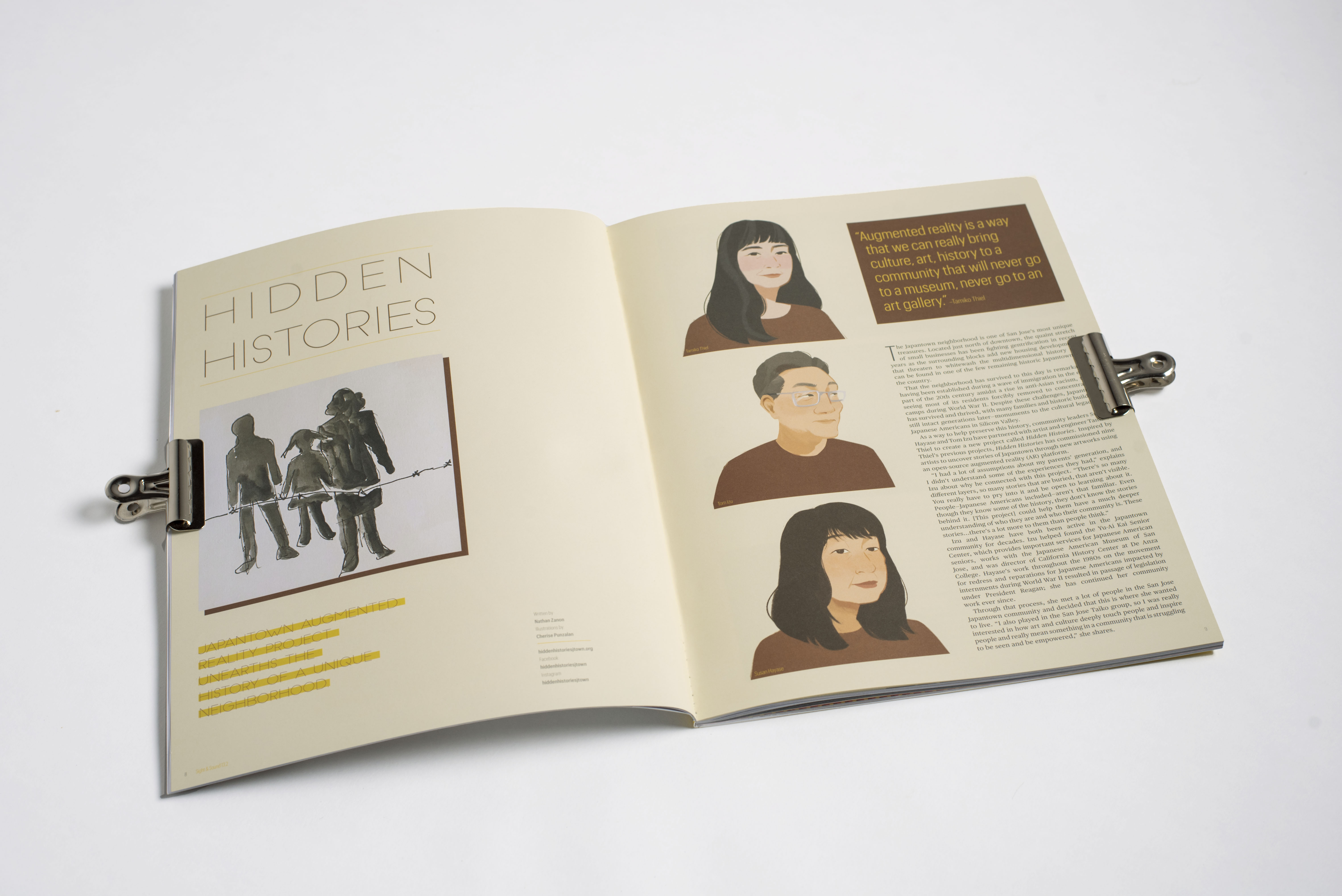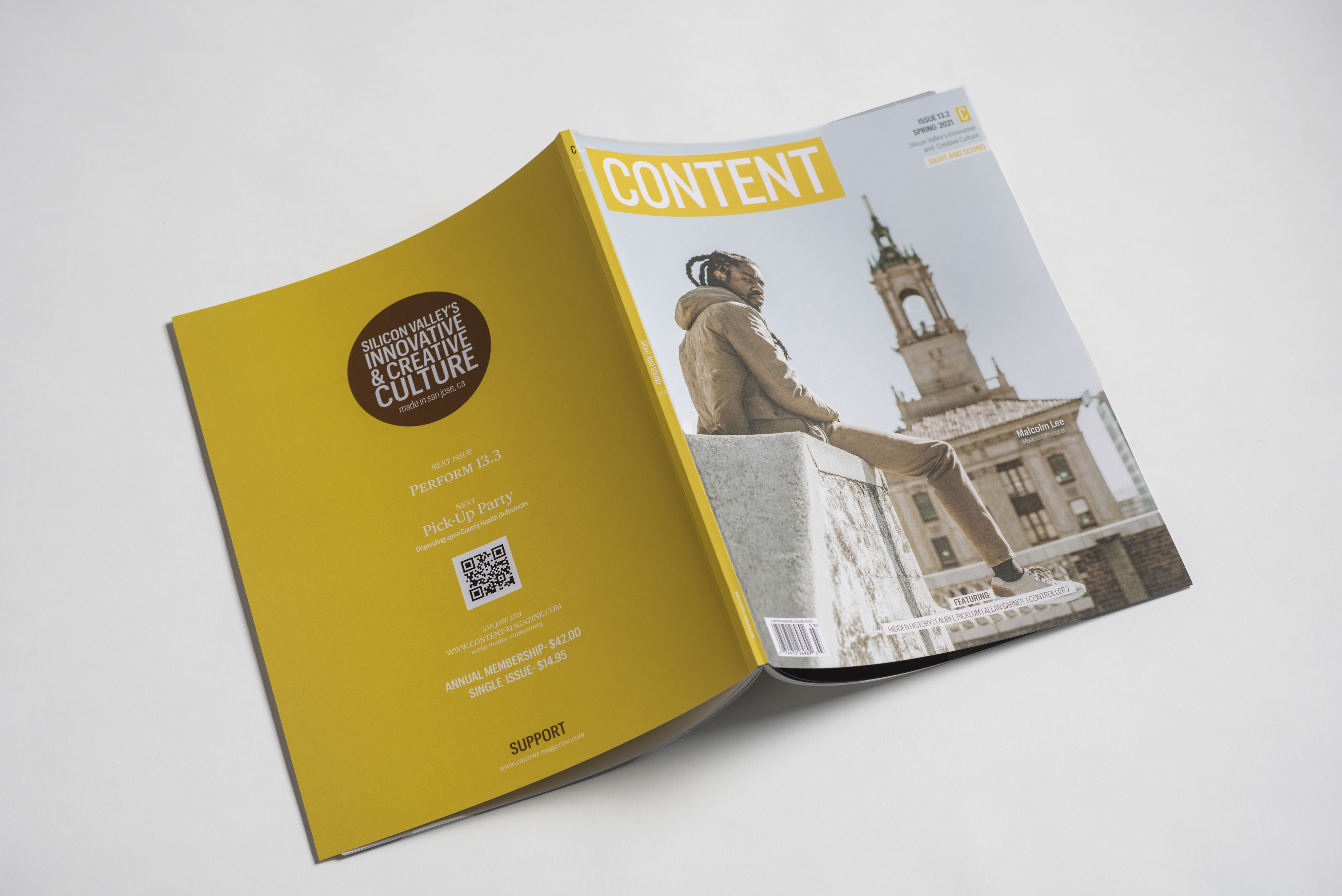
T he Japantown neighborhood is one of San Jose’s most unique treasures. Located just north of downtown, the quaint stretch of small businesses has been fighting gentrification in recent years as the surrounding blocks add new housing developments that threaten to whitewash the multidimensional history that can be found in one of the few remaining historic Japantowns in
the country.
That the neighborhood has survived to this day is remarkable, having been established during a wave of immigration in the early part of the 20th century amidst a rise in anti-Asian racism, then seeing most of its residents forcibly removed to concentration camps during World War II. Despite these challenges, Japantown has survived and thrived, with many families and historic buildings still intact generations later—monuments to the cultural legacy of Japanese Americans in Silicon Valley.
“Augmented reality is a way that we can really bring culture, art, history to a community that will never go to a museum, never go to an art gallery.”–Tamiko Thiel
As a way to help preserve this history, community leaders Susan Hayase and Tom Izu have partnered with artist and engineer Tamiko Thiel to create a new project called Hidden Histories. Inspired by Thiel’s previous projects, Hidden Histories has commissioned nine artists to uncover stories of Japantown through new artworks using an open-source augmented reality (AR) platform.
“I had a lot of assumptions about my parents’ generation, and I didn’t understand some of the experiences they had,” explains Izu about why he connected with this project. “There’s so many different layers, so many stories that are buried, that aren’t visible. You really have to pry into it and be open to learning about it. People—Japanese Americans included—aren’t that familiar. Even though they know some of the history, they don’t know the stories behind it. [This project] could help them have a much deeper understanding of who they are and who their community is. These stories…there’s a lot more to them than people think.”
Izu and Hayase have both been active in the Japantown community for decades. Izu helped found the Yu-Ai Kai Senior Center, which provides important services for Japanese American seniors, works with the Japanese American Museum of San Jose, and was director of California History Center at De Anza College. Hayase’s work throughout the 1980s on the movement for redress and reparations for Japanese Americans impacted by internments during World War II resulted in passage of legislation under President Reagan; she has continued her community
work ever since.
Through that process, she met a lot of people in the San Jose Japantown community and decided that this is where she wanted to live. “I also played in the San Jose Taiko group, so I was really interested in how art and culture deeply touch people and inspire people and really mean something in a community that is struggling to be seen and be empowered,” she shares.
Though Thiel now lives in Germany with her husband, she and Hayase have their own history: the two attended Stanford together, then worked at Hewlett-Packard (HP) in the late 1970s while rooming together, before Thiel departed the Bay Area for her work. In the subsequent years, the two have stayed in occasional contact, Hayase eventually urging her old friend to help her create a project for San Jose, a place where she has deep roots.
“My family had immigrated to the Santa Clara Valley in like 1908—that’s where my grandmother was born,” Thiel says, uncovering a story of her own hidden history in the region. Her grandmother met her grandfather at the Wesley Methodist Church in San Jose. For years Thiel has known a photograph of the two of them in front of a house, and she recently found out that it’s the Norman Mineta house.
Born in Oakland, Thiel grew up in Seattle. She returned to the Bay Area to attend Stanford and work at HP, moved across the country for grad school at MIT in Boston, and eventually wound up working as a product design engineer in Munich. Eventually, she decided her calling was to fuse her creative instincts with her engineering skills, and she became deeply involved with virtual reality technology, creating her first large-scale installation in 1995 with a piece called Beyond Manzanar, inspired by the concentration camp that was located in the eastern Sierras.
Later, her installations evolved into augmented reality (AR), including Mi Querido Barrio, another storytelling piece located in East Harlem in New York and Brush the Sky, a piece Thiel created with her mother, generating virtual calligraphy in the skies above Seattle.
When Thiel first started doing AR projects, Hayase was immediately wanting to bring it to Japantown and kept asking her if she would do a project in San Jose, because she could see that it would really enhance people’s understanding of deeper things that you can’t see with your own naked eyes.
AR is becoming more commonplace, used in cell phone games and in filters that map disguises onto people’s faces using the phone’s camera. For Hidden Histories, a visitor will download an app and use it in specific locations around Japantown, where they will point their camera to reveal the “hidden” artwork.
Despite being in the heart of Silicon Valley, technology doesn’t come easily to everyone just because they live here. The team made an effort to choose artists both familiar and unfamiliar with using tech in their work, creating an interesting dynamic of creative ideas.
“I thought being right in Silicon Valley, there’d be people who could instantly help us, they would just fall from the trees like, ‘Oh, I know how to do this, I’ll just show you right now,’ but there’s this divide in Silicon Valley. We’re right in the heart of this high-tech world, but a lot of communities aren’t part of that infrastructure,” Hayase points out. “It’s very ironic that we’re going to take this specific community that predates Silicon Valley, and we’re going to take this technology that they want to sell us, but we’re going to use it for a purpose that they didn’t even think of. We’re going to use it to remind people about the actual people that lived here and the actual kinds of lives they had, the actual stories and their hopes and dreams. We’re very happy about that.”
With this subversion of Silicon Valley corporate culture in mind, Thiel insisted on using an open-source platform that would retain the content indefinitely, instead of one owned by a tech giant that could be discontinued on a whim, rendering the projects lost to history once again. This platform also keeps open the possibility of continuing to add to the project and creates an ever richer tapestry of art, history, and exploration. “Augmented reality is a way that we can really bring culture, art, history to a community that will never go to a museum, never go to an art gallery,” she says.
Set to debut in spring of 2021, Hidden Histories will showcase the stories of Japantown for a new generation, preserving an important part of our city’s heritage.
Facebook
hiddenhistoriesjtown
Instagram
hiddenhistoriesjtown
Article originally appeared in Issue 13.2 “Sight and Sound” 2021


